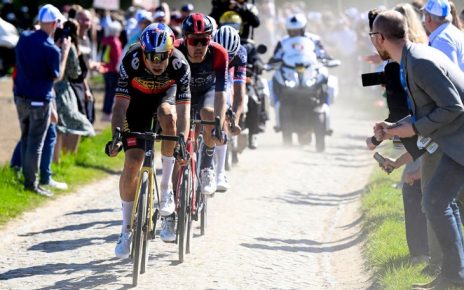Cyclocross Magazine columnist and pro racer Corey Coogan Cisek was the last American standing at European cyclocross races. She escaped Europe’s winds and left before the COVID-19 threat, and now checks in with her final Cyclocross Apprenticeship entry of the season. It’s a great one. Here is Part One of her season wrap-up.
Perhaps you remember the final race of 2019, Oostmalle?
I do. Since my 90 days in the Schengen Zone were up, I watched it from my couch in the U.S. I remember it as the day my coach Helen Wyman retired and hung up her bike, literally.
It was also a bright, sunny day where everyone raced in short sleeves!
Naturally, we dreamed of ending the 2020 season in the sun like last year. Heck, I think we felt we deserved it!
It was not to be. This year’s Oostmalle was blustery and rainy, a true Belgian end to the season.

Following Laura Verdonschot on the way to Oostmalle. Corey Coogan Cisek wraps up the 2019-2020 European cyclocross season.
The wind was an ever-present factor in the final weeks of the Belgian season. From the race that was canceled, Merksplas, to the race that was nearly canceled, Hulst, to many training rides keeping one’s bike upright between gusts…..
While an orange wind warning means a race is likely canceled (Merksplas was canceled under orange), by the end of the season, a yellow wind warning was essentially “ho-hum, business as usual.”
Oostmalle took place under a yellow wind warning.
While on television, Oostmalle may look like a beach, in reality, the race takes place on a “reserve NATO airport.” The drive to rider parking is via a runway. Likewise, rider parking is on a runway. A runway is not a great place to be during a yellow wind warning.
It was one of those days when erecting a tent for warm-up seemed foolhardy, but since it was raining (sideways), our Cyclocross Custom mechanics tried nevertheless. They assessed the wind direction (varied) and attempted to set up in the lee of our vehicles.
For a while, my de facto “teammate” Michelle Geoghegan and I provided our assistance by hanging onto the tent while it was being secured. However, we left for “inscrijving” (registration), once mechanic Jo Vande Velde, hanging onto the tent itself, assured they had it under control.
Inscrijving was delayed due to a minor incident. In fact, we arrived at the inscrijving trailer just after the local fire department did.
It seems someone had failed to hold onto the door when opening it. The door had blown back, hitting the building and causing a series of spider cracks in the door’s window.
Oostmalle’s finest brandweer (firemen) made repairs to the glass via duct tape. Since the glass was wet from the rain, they had trouble getting the tape to stick. No fear, someone located a roll of paper towels.
One of the registration officials had opened one of the building’s windows to instruct the brandweer. For a moment, I hoped that registration might be conducted through the window. As I approached, the official hastily closed the window in my face. It was the “service with the smile” approach that’s not uncommon at Belgian races. Such abruptness and lack of warmth used to alarm me, but now I just roll my eyes.
Number pickup and pre-ride complete, Michelle and I made the long, headwind ride back to camp.
For Oostmalle, we were parked a veritable journey from the course per being “individuals” (read, bottom of the totem pole), rather than a team (preassigned parking).
At least the commute back to camp allowed us to check out teams’ warm-up setups. It seemed the minimum configuration allowing for a tent or awning to survive the wind was 3 RVs parked in a C-formation.
We ran into our Cyclocross Custom mechanics some distance from camp. They displayed an unusual grin and seemed to be holding back laughter. Our lead mechanic, Denis Dhont asked, “Um, is it okay, if you do not warm-up under a tent today?”
Keep in mind that it was raining sideways when he asked.
I’m not actually certain what happened to the tent. I was just relieved to see that Jo (last seen holding the tent) was still around, rather than aloft somewhere. Given our mechanics’ dedication to providing a good warm-up space, I am quite certain the tent is no more.
Postseason Courses
The post-Worlds courses are of a particular type. They tend to be short and not what I term “fitness courses.” There are exceptions. Hoogstraten, which no longer exists and was replaced by Merksplas, was a heavy mudder even on the driest of days. Middelkerke had long stretches of running in 2019, causing plenty of suffering. Oostmalle, with its sand, could have been a hard effort were it not for the rain taming the sand into “single track riding” rather than heavy, squirrely ruts.
It makes complete sense when you think about it. If post-Worlds, there was a race like Koksijde, Zonhoven, Koppenburg, Ronse or Overijse, fitness races filled with pain, riders would likely revolt. I assure you, we would!
In fact, if you look at next year’s UCI calendar, the pattern holds. Both the early season and late season races are relatively “easy.” The truly iconic races, the sufferfests, are late-October to Kerstperiode.
The tortuous middle, the “meat of the season,” with its classic races, is my favorite.
The great fitness I brought from Florida into the last block did not serve me well, particularly on the post-Worlds courses. These courses were speedy and technical with neither a hill nor a long run to be found. Sadly, via Florida’s solo efforts and lack of racing, I lost what little speed my genetics allow. It also took time to refind my Belgian technical skills upon return. I was mentally fresh, but that’s only a piece of the puzzle.
Holidays on the Brain…of Almost Everyone
The post-Worlds rider mood is chill. Rest and spring seem to be right around the corner. It’s hard to be bothered to race with passion.
The race delay in Hulst captured our mood. The 20-minute delay was announced after many riders had already arrived at the start. In Europe, it’s customary for riders to spin a loop on the start/finish stretch as we await call-ups. Most riders also do a couple of accelerations off the 180-turns in final preparation for the start. Yet, in Hulst, we mostly sedately spun in circles. Only a few accelerations occurred. We were chatting and spinning, less hyped than normal about the upcoming race.
Even with my post-Florida fresh-as-a-daisy feels, I was similarly chill. Like everyone (most everyone), I could smell the end of the season. Although I wasn’t weary from racing, I was plenty weary from travel. I raced my hardest and was professional in my approach, but the midseason race stress and anxiety had disappeared. The season’s “story” was already written. My results weren’t likely to differ much from what they had already been.

Corey Coogan Cisek wraps up the 2019-2020 European cyclocross season in the wet sand of Oostmalle. photo: Hans van der Maarel
Nevertheless, there was one rider with energy in spades: Denise Betsema.
Have whatever opinion you may about Denise, her suspension length, etc., but one thing is for sure: she was a whole lot fresher than the rest of us…and no doubt determined to make up for lost time.
In Leuven, Denise killed it. When I got pulled there, I thought it was “an early pull,” but Denise went by alarmingly soon thereafter. Anne Marie Worst (purportedly sick the night before) was significantly dropped by Betsema and looked cross-eyed when she passed.
In Oostmalle, Worst took the win, but she and Betsema rode away from the rest of the field. With Ceylin absent, what would the pace have been without Betsema?
No doubt, Betsema’s return injected some speed into the late-season racing. For those of us in the field, it was unusually hard to stay on the lead lap on the short, late-season courses!
The Dutchies Are Flying
It’s not just Denise who was going well at the end.
I have an unusual perspective as a result of finishing further back in the field, behind where the cameras film.
The skills at the back end of the field often outstrip those at the front. Really, hear me out.
Last year, I was very surprised to be dropped at the barriers in Essen when a junior rider bunny-hopped them.
This year, bunny-hopping the barriers was pervasive later in the field (where the U23 and junior riders typically finish). In fact, in the early laps, I made a point of checking who around me was bunny-hopping. I needed to have a gap on these riders going into the barriers, or I would have to chase back on.
Who is bunny hopping the barriers among the top riders? Not Ceylin, not Anne Marie, not Denise, not Sanne, not Yara, not Lucinda…Anna Kay is, but the majority are not.
However, the next generation is bunny-hopping. Many are also riding technical off-cambers, steep ups and downs, etc. better than the top riders.
Where I exist back-of-the-pack, I am routinely dropped by “not-many-watts-per-kilo” little Dutch girls with mad skills.
If I rode among the top-20 riders, I would feel it was my fitness, not my skills, that is sorely lacking. Back where I exist, I have the “opportunity” to feel like a clutz among graceful little deer.
Why the Dutch and Not the Belgians?
Cycling culture.
Dutch girls have been racing bikes since Marianne Vos was a child. Vos wasn’t an anomaly as a Dutch girl racing a bike. Rather, starting at age 8, she was able to join a club and race with other riders her age.
Vos’ younger peer Sanne Cant was an anomaly in Belgium. In fact, girls are just starting to race bikes with regularity in Belgium. If you attend a junior competition (as I did in 2017), nearly the entire field is boys.
Likewise, the Dutch have a tremendous cyclocross practice culture. There is a video floating around the web that shows a weekly practice in Holland. The practice takes all-comers. Thus, the younger Dutch riders train amongst the World’s best. How’s that for motivation?
The Dutch also have competitions known as “dikke banden” races. These are easy, entry-level races, which are often free and don’t require a real cyclocross or mountain bike. This format gets more riders to try CX, and the larger your talent pool…
Stay tuned for Part Two of Corey’s final column of the season.






